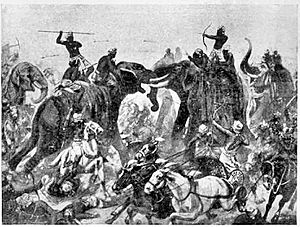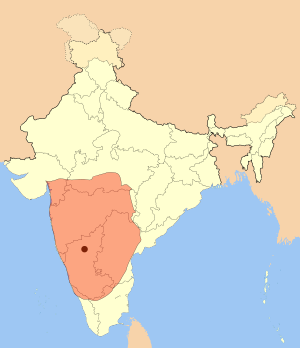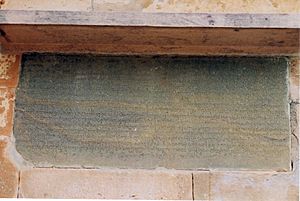Pulakeshin II facts for kids
Quick facts for kids Pulakeshin II |
|
|---|---|
| Satyashraya, Shri-prithvi-vallabha, Bhattaraka, Maharajadhiraja, Parameshvara, Karnateshwara | |
| Chalukya king | |
| Reign | c. 610 – c. 642 |
| Predecessor | Mangalesha |
| Successor | Adityavarman |
| Dynasty | Chalukyas of Vatapi |
| Father | Kirttivarman I |
Pulakeshin II (ruled around 610–642 CE) was the most famous king of the Chalukya dynasty. This powerful kingdom was based in Vatapi (which is now Badami in Karnataka, India). During his time, the Chalukya kingdom grew to cover most of the Deccan region in southern India.
Pulakeshin was the son of King Kirttivarman I. He took the throne by defeating his uncle, Mangalesha. Pulakeshin then put down a rebellion by Appayika and Govinda. He also strongly defeated the Kadambas of Banavasi in the south. Other kingdoms like the Alupas and the Gangas of Talakadu accepted his rule. He made sure the Chalukyas controlled the western coast by conquering the Mauryas of Konkan. His famous Aihole inscription also says he defeated the Latas, the Malavas, and the Gurjaras in the north.
One of Pulakeshin's biggest achievements was his victory over the strong northern emperor Harshavardhana. Even the Chinese traveler Xuanzang wrote about Harsha's failure to conquer the Chalukya kingdom. In the east, Pulakeshin defeated the rulers of Dakshina Kosala and Kalinga. After beating the Vishnukundina king, he made his brother Vishnu-vardhana the governor of the eastern Deccan. This brother later started his own independent kingdom, the Eastern Chalukya dynasty of Vengi. Pulakeshin also had some success against the Pallavas in the south. However, he was eventually defeated and killed during an invasion by the Pallava king Narasimhavarman I.
Pulakeshin followed the Vaishnava faith (worshipping Vishnu). But he was also very accepting of other religions. These included Shaivism (worshipping Shiva), Buddhism, and Jainism. He supported many smart people, like Ravikirtti, who wrote the Aihole inscription.
Contents
What's in a Name?
Pulakeshin had a few names and titles. His name appears as Pulikeshin and Polekeshin in old records. Another name he used was "Ereya." Historians think Ereya might have been his name before he became king.
One of his special titles was Satyashraya, which means "refuge of truth." This title was often used instead of his name in official documents. He was such a famous king that later rulers called their family "Satyashraya-kula," meaning "family of Satyashraya."
He also used grand titles like Bhattaraka and Maharajadhiraja, which means "King of great kings." After defeating Emperor Harsha, he took the title Parameshvara, meaning "Supreme Lord."
The Chinese traveler Xuanzang called him Pu-lo-ki-she. A Persian historian named Al-Tabari called him Paramesa or Pharmis, which might be a Persian way of saying Parameshvara.
How Pulakeshin Became King
Pulakeshin was the son of King Kirttivarman I. When Kirttivarman died, Pulakeshin was still young. So, his uncle Mangalesha became the next king.
Later records from another Chalukya family say that Mangalesha ruled because Pulakeshin was a child. They also wrongly claim that Mangalesha gave the kingdom back to Pulakeshin when he grew up. But Pulakeshin's own Aihole inscription tells a different story. It seems Pulakeshin had to fight his uncle to become king.
The Aihole inscription says that Mangalesha was jealous of Pulakeshin. Pulakeshin was very lucky and skilled. So, Pulakeshin went away from the kingdom for a while. He then used his smart ideas and energy to make Mangalesha weak. In the end, Mangalesha lost his chance to make his own son king, lost his kingdom, and lost his life. This means Pulakeshin defeated and killed Mangalesha to take the throne.
Pulakeshin's Hyderabad inscription, from his third year as king (around 613 CE), shows he became king around 610–611 CE.
Pulakeshin's Military Victories
After Mangalesha's death, Pulakeshin faced many challenges. Some people were loyal to Mangalesha, and others wanted to take advantage of the confusion. The Aihole inscription says the world was "covered in darkness" by his enemies. But Pulakeshin defeated them all and made the Chalukyas the strongest power in southern India.
Defeating Rebels
The Aihole inscription mentions two rulers, Appayika and Govinda, who rebelled against Pulakeshin. They came from the north of the Bhima River in present-day Maharashtra. Pulakeshin used a clever strategy: he made Govinda his friend and ally, which helped him defeat Appayika.
Pulakeshin's family had already defeated the Kadambas of Banavasi before. But the Kadambas stopped accepting Chalukya rule during Pulakeshin's time. Pulakeshin marched against them and surrounded their capital, Banavasi. The Kadambas fought hard, but Pulakeshin defeated them. He ended their dynasty and added their land to his empire. He then gave parts of this land to his loyal allies, like the Alupas.
Stopping the First Arab Invasion
Around 636 CE, the first Arab invasion of India happened by sea. They tried to conquer Thana, near Mumbai. This was during the time of the second Caliph, Umar-bin-Akhtab, who wanted to spread Islam. The Arab naval force was sent to capture Thana on India's western coast. However, the Chalukya Navy, led by Pulakeshin II, successfully fought them off. The Arabs had to return to Oman. This was the first time an Arab raid on India was defeated.
Allies and Vassals
Pulakeshin also brought the Alupas and the Gangas of Talakadu back under Chalukya control. These kingdoms had been under his family's rule before, but might have tried to become independent during the fight between Pulakeshin and Mangalesha. The Ganga ruler Durvinita even married his daughter to Pulakeshin. She became the mother of Pulakeshin's son Vikramaditya I.
Pulakeshin's father had also defeated the Mauryas of Konkana (present-day Konkan). They had declared independence during the Chalukya family conflict. Pulakeshin successfully attacked their capital, Puri, and brought them back under his rule.
Northern Neighbors
The Aihole inscription says Pulakeshin also defeated the Latas, the Malavas, and the Gurjaras in the north. These kingdoms might have accepted Pulakeshin's rule to protect themselves from the powerful northern king Harshavardhana. Pulakeshin put a member of his own family in charge of the Lata region (southern Gujarat).
Victory Over Harsha
Pulakeshin's most famous military victory was against Emperor Harsha. Harsha ruled a large part of northern India. Pulakeshin's later inscriptions always mention this victory.
The exact date of this war is debated, but it happened sometime before 619 CE. Harsha might have invaded the Chalukya kingdom to take advantage of the family conflict. Or, Pulakeshin might have protected the northern kingdoms that were Harsha's enemies.
The Aihole inscription proudly says that Harsha's happiness "melted away by fear" as his elephants fell in battle. Harsha's own court poet did not mention this defeat, but other sources confirm Pulakeshin's success. The Chinese traveler Xuanzang visited Pulakeshin's kingdom and confirmed that Harsha could not conquer it. Xuanzang said Harsha had conquered many nations, but the people of Pulakeshin's kingdom refused to accept his rule. Harsha tried to punish them with his army but failed.
The battle likely took place near the Narmada River. Pulakeshin's army stopped Harsha from crossing the river and invading the south.
Eastern Conquests
Pulakeshin also conquered the rulers of Dakshina Kosala (parts of present-day Chhattisgarh and Odisha) and Kalinga (parts of Odisha and Andhra Pradesh).
He then invaded and captured Pishtapura (modern Pithapuram in Andhra Pradesh). He also fought a big battle near Kunala lake (now Kolleru Lake). These battles were against the Vishnukundina dynasty. Pulakeshin defeated them and made his younger brother, Vishnu-vardhana, the governor of this new eastern territory. Vishnu-vardhana later started the independent Eastern Chalukya dynasty.
Xuanzang's Visit to Pulakeshin's Kingdom
The famous Chinese traveler Xuanzang visited Pulakeshin's kingdom in 641–642 CE. He called the Chalukya kingdom "Mo-ho-la-cha," which is how he wrote "Maharashtra." He confirmed that Pulakeshin had defeated Harsha.
Xuanzang described Pulakeshin as a "farsighted" and "astute" king who was kind to everyone. He said the king's people were "tall and sturdy" and "proud and carefree." They were grateful for kindness and sought revenge for injustice. They would rather die than be disloyal.
Xuanzang noted that the king was warlike and loved "military arts" because he was a Kshatriya (warrior class). His army had thousands of soldiers and hundreds of elephants. These elephants were used to break through enemy lines.
Xuanzang mentioned that there were over 100 Buddhist monasteries in the kingdom, with more than 5,000 monks. He specifically described a large monastery that modern scholars believe is the Ajanta Caves.
War with the Pallavas and Defeat
The Pallavas were the Chalukyas' southern neighbors. Pulakeshin's conquest of the Vishnukundinas, who were allies of the Pallavas, led to conflict between the two powerful kingdoms.
The Aihole inscription says that Pulakeshin's army caused so much dust that it obscured the Pallava king's glory. The Pallava king had to hide behind the walls of his capital, Kanchipuram. However, Pallava records say their king Mahendravarman defeated an unnamed enemy at Pallalura (modern Pullalur). These two accounts might be about the same battle, which was probably not a clear win for either side. The Pallavas might have retreated to Kanchipuram but caused enough damage to make Pulakeshin go back to Vatapi.
Pulakeshin also defeated the Banas, who were likely allies of the Pallavas. This probably restarted the conflict with the Pallavas. The Aihole inscription suggests Pulakeshin got the Chola, Chera, and Pandya kings to join him against the Pallavas. He marched towards Kanchipuram again. But Pallava records say he lost battles at Pariyala, Suramara, and Manimangala, near Kanchipuram.
Finally, the Pallavas, led by King Narasimhavarman I, attacked the Chalukya capital, Vatapi. Pulakeshin was likely killed when the Pallava army captured Vatapi around 642–643 CE. An inscription in Badami confirms the Pallava occupation of Vatapi.
The Kingdom's Size
The Chinese traveler Xuanzang said that Pulakeshin ruled a very large, strong, and rich kingdom through many loyal allies. The Aihole inscription says Pulakeshin's kingdom was bordered by oceans on three sides. This suggests he ruled a huge part of southern India, south of the Vindhya mountains. However, he probably didn't fully control the far southern kingdoms like the Cholas, Cheras, and Pandyas.
After beating Harsha, Pulakeshin controlled a large part of western Deccan, south of the Narmada River. The Aihole inscription says he gained control of "three Maharashtrakas," which included 99,000 villages. These might have been Maharashtra, Konkan, and Karnataka.
Pulakeshin couldn't rule such a huge kingdom from one place. So, he had governors from his own family and loyal allies rule different parts. For example, his younger brother Vishnu-vardhana became the governor of Vengi in the eastern Deccan. Vishnu-vardhana later became an independent ruler.
Friends in Faraway Lands
The Persian historian Al-Tabari wrote that Pulakeshin ("Pharmis") had friendly relations with the Sasanian ruler Khosrow II of Persia (modern-day Iran). Pulakeshin sent valuable gifts and letters to Khosrow and his sons around 625 CE.
Some earlier historians thought a painting in Ajanta Cave 1 showed a Persian embassy visiting Pulakeshin's court. The painting shows people in foreign clothes. However, this theory is no longer believed to be correct. The painting actually shows a story from the Jataka tales, where the king is the Buddha in a past life. The many people in Persian clothing in the Ajanta caves likely show that many Persian traders or workers were in Central India at that time.
The good relations between India and the Sasanian Empire encouraged Zoroastrians to move to India. They were being persecuted by the rise of Islam. They settled on the west coast of the Deccan and became the Parsi Community.
Pulakeshin's Beliefs
Pulakeshin was a Vaishnavite, meaning he worshipped Vishnu. Some of his inscriptions call him a "devotee of Vishnu." Many of his inscriptions start with prayers to Vishnu and have seals with varaha, an incarnation of Vishnu.
He was very accepting of other religions. The building of Shaivite (Shiva-worshipping) temples, like the Upper Shivalaya and Lower Shivalaya, began during his rule. The Chinese Buddhist traveler Xuanzang said there were over 100 Buddhist monasteries in his kingdom, with more than 5,000 monks living there. The Meguti Jain temple at Aihole was also built during his time by Ravikirrti, who wrote the famous Aihole inscription on its wall.
Art and Learning
Pulakeshin's Aihole inscription says he was generous in giving gifts and honors to brave people and scholars. Ravikirrti, his court poet, said he was as good as famous Sanskrit poets like Bhasa and Kalidasa.
Important Inscriptions
Many inscriptions from Pulakeshin's time have been found. They tell us a lot about his reign:
- The Hyderabad copper-plate grant from 613 CE records a village grant.
- The Maruturu grant mentions the capture of Pishtapura.
- The Lohner inscription from 630 CE records a village grant.
- The Kopparam copper-plate inscription from his 21st year as king records another village grant.
- The Aihole prashasti inscription, written by Ravikirtti, lists Pulakeshin's military achievements and the building of a Jain temple.
- The Chiplun copper-plate inscription mentions a grant and refers to his maternal uncle, a vassal king.
- The Bijapur-Mumbai copper-plate grant from 619 CE records a land grant and praises the dynasty and its kings. This inscription was only recently cleaned and published in 2017.
Some other inscriptions are thought to be fake by modern scholars because of their writing style or dating.
Images for kids
-
Original frescoes in Ajanta Cave 1, and corresponding artistic depiction of Pulakeshin receiving envoys from Persia. Earlier scholars believed that Pulakeshin received an envoy from the Sasanian emperor of Persia, based on the Ajanta cave painting, but this theory is no longer considered correct.




